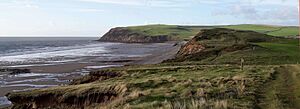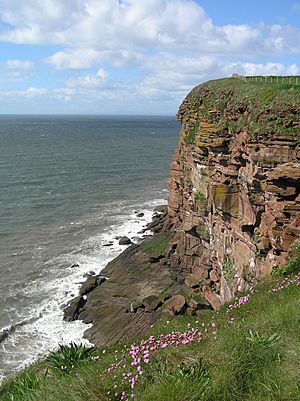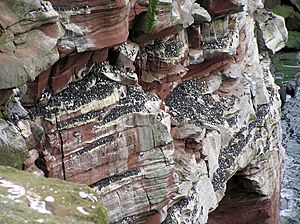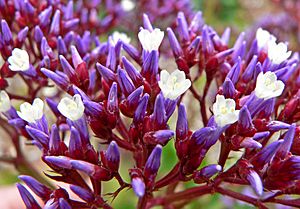St Bees Head facts for kids
Lua error in Module:Location_map at line 420: attempt to index field 'wikibase' (a nil value). St Bees Head is a special place on the coast of Cumbria, in the North West of England. It's named after the nearby village of St Bees.
This headland is the only part of the English coastline between Wales and Scotland that is a "Heritage Coast." This means it's a beautiful area protected for its natural beauty and wildlife. It's also a Site of Special Scientific Interest (SSSI), which means it's important for its plants, animals, or geology. The sea nearby is also protected as a Cumbria Coast Marine Conservation Zone, helping to keep the ocean healthy.
St Bees Head is popular with walkers. Two famous long-distance footpaths follow the cliffs here: the Cumbria Coastal Way and Wainwright's Coast to Coast. The cliffs are very tall, reaching 90 metres (about 295 feet) above the sea. From the top, you can see amazing views of the Cumbrian mountains and the coast.
Contents
North Head: England's Western Edge
The North Head is the actual furthest point west in Northern England. This is where you'll find the St Bees Lighthouse. During World War II, a radar station was here, and you can still see some of its old buildings near the lighthouse. There's also a disused foghorn building. The lighthouse still works today, but no one lives there anymore.
Close to the coastal path, north of the lighthouse, is Birkhams quarry. This quarry still digs up St Bees sandstone, a special type of rock from this area. The rocks along the sea at the North Head are a popular spot for climbers. They use the rocks for bouldering and have set up climbing routes on the cliff face.
Bird Reserve: A Home for Seabirds
The RSPB looks after a special nature reserve here. It's a busy home for many seabirds like kittiwakes, fulmars, guillemots, razorbills, cormorants, puffins, shags, and herring gulls. St Bees Head is the only place in England where black guillemots come to breed.
Other birds also live and raise their young here regularly. These include tawny owls, sparrowhawks, peregrines, ravens, and rock pipits. The rock pipit only breeds in one other place in Cumbria! You can find special spots on the North Head footpath to watch these amazing birds.
South Head: Tomlin and Views
The South Head is known by locals as "Tomlin." It stands tall over the long, sandy St Bees Beach. If you walk up the footpath from St Bees, you'll find the remains of an old coastguard lookout. This spot now has a viewing table, perfect for enjoying the scenery.
Fleswick Bay: A Hidden Gem
Between the North Head and South Head is a beautiful place called Fleswick Bay. You can only reach it by walking or by boat. It has a shingle beach, which is made of small, smooth stones. This beach sits on a "wave-cut platform," a flat area of rock created by the sea. High sandstone cliffs surround the bay. The Coast to Coast walk goes down into Fleswick Bay on its way to the North Head.
Flora: Plants of the Cliffs
The rugged cliffs at St Bees Head are home to many different kinds of plants. This is because of the unique rock formations. Closer to the sea, you can find plants like sea pink (also called thrift), common scurvygrass, sea campion, sea spleenwort, and rock samphire. There's also a rare plant called rock sea lavender.
Near the top of the cliffs, you might spot bloody cranesbill, wood vetch, orpine, and soft shield-fern. Along the very top of the cliffs, you'll see dyer’s greenweed, western gorse, heather, and bracken.
Physical Features: The Red Sandstone Cliffs
The cliffs at St Bees Head are made of red sandstone. This rock formed about 200 million years ago from sand carried by water. St Bees sandstone has very tiny grains, which makes it easy to work with. Because of this, it's still very popular for building today. The tiny pieces of mica in the stone make it sparkle! Even though this type of sandstone is found further north, it's named after its most famous spot here at St Bees.
The SSSI description talks about the interesting geology here. You can see how the sea has shaped the land, creating "wave-cut notches" (cuts in the cliff) and "wave-cut platforms" (flat rock areas). On St Bees Beach to the south, there are nine "groynes." These are structures built out into the sea to help stop sand from being washed away by the currents.
Further south on St Bees Beach, there are small mud cliffs. These are great places to study "glacial moraines," which are piles of rock and dirt left behind by ancient glaciers. The shingle (small stones) on both St Bees Beach and Fleswick Bay shows a huge variety of stones that were carried here by glaciers long ago.
Images for kids












